Bedford
Cinema History
Places > Bedford > Cinemas > Bedford Cinema History Project
Cinema memories
Home | Going to the Pictures | My Cinema Memories |Cinema in London | More Memories

Going to the Pictures in Bedford, 1940s to 1960s
by Graham Trundley
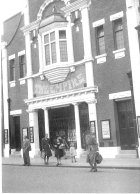 My family lived very close to the town centre and could select from the
Empire, the
Plaza, the Picturedrome or the
Granada, and
like so many others we used them as our regular source of entertainment.
My family lived very close to the town centre and could select from the
Empire, the
Plaza, the Picturedrome or the
Granada, and
like so many others we used them as our regular source of entertainment.
Admission was modest, starting at 1/- (5p) for the front section of seating,
rising to the dizzy heights of 3/6d (17 ½ p) for the circle or back rows of the
stalls. I don’t think that we ever bought these, especially as the back rows
were thought to be for canoodling! Shows started after lunch and went on until
late evening with only one interval (for the sale of ice cream and Kia Ora) and
it was quite usual to enter at any point, stay until the story got to the place
when you had entered, then leave. If you weren’t busy, you could stay all day.
Programmes were changed on Thursday and Monday, and there was usually a separate
Sunday bill: there would be a main feature, a supporting ‘B’ film, plus a Pathé
newsreel, and maybe cartoons or public service specials. Elaborate trailers,
giving the exciting bits of the next weeks’ films were also shown. All four
cinemas had glass fronted cases fixed to their frontages for the display of
posters featuring coming films and scene stills or portraits of the actors.
These were taken down and forwarded to the next town with the reels of film.
Later, perhaps into the 50s there would be a Pearl and Dean session of
advertisement movies. The British Board of Censors graded every film as to
suitability for its audience, being U (universal), A (adult – 12 plus), X (very
adult), and I think there was also an H (for horrific?). Babes in arms were
specifically excluded from all performances.
In those innocent days, we children under 12 without a handy parent would
lurk outside the cinema and ask strangers to ‘take us in’, and then hand them
the admission money. Once inside we parted company: it seemed to work! It was
not unknown for personal messages to be flashed up at the bottom of the screen
on a hand-written strip, perhaps stating, ‘would so-and-so report to the box
office, where there is an important message for her’ or 'him' - and this would probably
be an irate parent calling them home for tea!
At the end of the evening the National Anthem would be played, and it was not
universally appreciated, especially if you had a last bus to (just) catch. If
you were quick and stood up as soon as the credits were rolling, you could
escape.
Queues for admission
were common and in many families, mine included, it was felt necessary to take
sandwiches, as you could be standing for up to an hour for a popular film. The
queue was for all seat prices, except at the Granada where there was a side
alley called Granada Street, and round plaques showing the various prices were
hung over the entry to divide customers. Part of it was even under cover by the
overhanging offices. There was by way of entertainment, a view of the cinema’s
air cleaning plant, and notices describing the function of each piece of the
equipment which could be seen through the large windows in the side of the
building. My favourite was the one quoting how much mud the water-sprays washed
out of the air.
At this time of course, smoking was common, and the screen could be seen through
a fog, particularly obvious as a column in the rays of light streaming out of
the projectors. Food was not available, especially in the war years and even
afterwards, initially, being restricted to ice cream and packets of Paines Poppets,
although eventually the Granada opened a sweet shop next to the foyer and then a
coffee bar alongside. Eventually, a counter serving ‘hot dogs’ was set up in the
inner foyer. There was a restaurant upstairs, overlooking St Peter's Street,
which served complete meals for a modest price. The commissionaire, resplendent
in a pseudo military uniform, with cap and scrambled egg would emerge at intervals to announce ‘two at
1/3d’ or ‘singles in the balcony’. There were also ‘standing only’ tickets and
you could then slip into a seat if someone left.
In the late evening you had to make running calculations as to whether it was
worth going in, as you would see only the main feature, having missed the
earlier supporting reels. Once inside, for all except the Granada, the lobby was
small, and tickets were sold through a window in the kiosk, shooting out from
the slot once the button was pressed. When you had your ticket, an usherette
armed with a huge chrome torch, showed you to your seat, which was necessary
because you generally went in during the running, not the beginning of the film.
The torches were also employed to spotlight anyone misbehaving or making too
much noise! At the Granada and the Empire the usherettes wore uniforms of royal
blue trousers, golden shirt and a short cape, all in shiny material: there was
also a ‘pillbox hat’. All this gave them definite authority.
The Granada being on a larger scale had a ticket hall, which led into the inner
lobby and the grand staircase to the upper seats and a restaurant. This cinema
had a Wurlitzer organ, supported sometimes on stage by a ‘ghost piano’, which
rose from under the stage bathed in spotlights, and a short recital would be
given, usually aided by the words of songs being projected onto the screen,
complete with bouncing ball to guide the audience through the words.
Both the Granada and later the Empire, ran Saturday morning shows for children,
popularly known as the sixpenny rush, and showing cartoons, a cowboy story where
the goodies wore white Stetsons and the villains black ones, and a space serial,
where rocket ships jerked across the screen on fairly obvious strings, but we
liked them! You were a Granadier or an Empire ranger (or both) depending on
which one you chose. There was a membership card and you got a free double
ticket on your birthday! As well as the films, there was often a quiz or a
‘spelling bee’ compèred by the manager. At some stage in the fifties a girls’
Granadiers Choir was formed, perhaps to keep up with the Luton Girls’ Choir and
the Littlewoods Pools Choirs. There wasn’t any real trouble with up to one
thousand unsupervised children, except when the love scenes or soppy bits came
on when the sound volume zoomed up. I recall once that a film stopped and the
manager appeared on stage and threatened to empty the cinema. That worked!
Stage shows were not uncommon, mainly at the Granada and many famous performers
did their training on the cinema circuit. For a long time the Granada promised
an improved stage show area, but it never appeared. There was also, throughout
the war, a large notice on spare ground behind the telephone exchange in St
Loyes, promising a completely new cinema – ‘but homes come first’ and that
vanished also.
Eventually, from about the time of the coronation in 1952, television arrived
and we had less need of going out for entertainment. The picture houses
disappeared one by one, to be replaced by a multi screen of six auditoria and the magnificent Granada was reduced
to an uneven car park.
© Graham Trundley
2013
My Cinema Memories - Bedford
by Alan Crawley
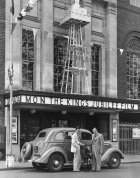 As a small boy I was an avid film goer. In
the school holiday time I would often go twice a week. If I remember correctly,
it cost sixpence to go in the first few rows back from the screen. In those
early days I would sit in the front row so as to be as close to the action as
possible. If I had run out of pocket money I used to get round my maternal
grandma who came to live with us just before the war when I was about 7 or 8. I
can remember her opening her handbag to find a sixpence and the strong smell of
perfume that came out. If she gave me a sweet from the handbag it would taste
of perfume.
As a small boy I was an avid film goer. In
the school holiday time I would often go twice a week. If I remember correctly,
it cost sixpence to go in the first few rows back from the screen. In those
early days I would sit in the front row so as to be as close to the action as
possible. If I had run out of pocket money I used to get round my maternal
grandma who came to live with us just before the war when I was about 7 or 8. I
can remember her opening her handbag to find a sixpence and the strong smell of
perfume that came out. If she gave me a sweet from the handbag it would taste
of perfume.
There was no problem with a U rated film but with A films children had to be accompanied by an adult. The way round this was to go up to complete strangers and ask them to take you in. I would give them my money so they could buy the ticket when they bought theirs and after getting well clear of the ticket office they would give me the ticket and I would disappear inside. I had to make sure the commissionaire (who always looked very impressive in his uniform) who prowled around outside did not observe the negotiations. It was easier to ask someone when there was a queue to get in. At the Granada the queue used to be formed down the passage way at the side that led to Lurke Street. I used to be fascinated looking in the window down the passage way that showed all the workings of their air conditioning system. They must have been very proud of it to display it in this way.
I had four cinemas to choose from, the Granada, Plaza, Empire and Picturedrome. That was also the order in which I rated them. The Granada was the best by a mile, followed by the Plaza, but there was not much to choose between the Empire and the Picturedrome. The Palace, situated on the north corner of Silver Street and High Street, was not an option as it had closed by 1936.
The usual programme was first the B picture that lasted for about an hour, after that a newsreel, a cartoon if I was lucky, adverts, the trailer of the films coming next week and then the A picture, which lasted for about an hour and a half. The newsreel at the Granada and I think the Empire, was Gaumont British. The Plaza and the Picturedrome had Movietone. As the programmes usually started at similar times (and possibly to cut costs) the Plaza and the Picturedrome would only have one newsreel copy, so you would often see a man running across the town bridge with a round metal case holding the newsreel. The best and newest films would usually be shown by the Granada but occasionally the Plaza would also manage to get one.
One of my two favourite films in the late thirties was The Adventures of Robin Hood (1938) which starred Errol Flynn. It might well have been the first film I had seen in Technicolor and really seemed to bring the adventure to life. I was interested in bows and arrows before seeing the film but I remember afterwards returning to my hobby with renewed vigour. Later in life I became a marksman using a .303 rifle but after that I returned to the bow and arrow having joined Bedford Archery Club where I went on to shoot in the Bedford team against surrounding towns.
The other of my favourite films was Oh, Mr Porter (1937) starring Will Hay. This was the story of a very inept station master who was sent to a very small station in Northern Ireland mainly to get him out the way. This was a comedy very much enjoyed. The plot was similar to that of The Ghost Train by Arnold Ridley (Pte. Godfrey in Dad’s Army).
Every so often the Granada would feature an organist playing during the break between the B and A picture. I remember some of the names, Reginald Foorte, Reginald Porter Brown and the most famous one, Reginald Dixon. There were others but the Reginalds seem to have stuck in my mind. Reginald Dixon was a household name, regularly broadcasting mainly from the Tower Ballroom in Blackpool where he was the resident organist. He was a friend of the family and my father Sydney, who was the local Ford dealer, sold him a Ford V8 saloon (see photograph below). At the Granada the organ rose up from just in front of the stage and Reginald Dixon would look immaculate in a white suit. Often there would also be a white grand piano on the stage which he could operate from the organ. You would see the piano keys eerily moving with nobody near them.
During the war Bedford organised Holidays at Home Weeks during the summer as people were not able to get away. One of the events in September 1942 was a stage show at the Granada featuring Geraldo and his Orchestra who were very well known and popular at the time. The second half of the show was broadcast by the BBC. I was extremely interested in big bands and so I went to the show and afterwards managed to get Geraldo (real name Gerald Bright) to autograph my programme. (see photograph below).
My cousin Michael Whitworth, as one of his ventures, for a short time ran the cinema in Sandy. I remember him inviting my brother and me to go there. After the show I asked him how the venture was going and whether it was profitable. It was during the winter but I told him I thought it was extremely hot and that surely he could cut expenses by turning down the heat. He told me he kept it very hot as it increased his ice cream and soft drink sales by a large amount.
Back at the end of the 19th century my great grandfather Joseph Crawley was an ironmonger and whitesmith in Midland Road. He married Frances Chetham the daughter of Samuel Chetham, boat builder also of Midland Road. In the same road were the photographers Blake and Edgar. As you will read elsewhere, the Chethams and the Blake Brothers were instrumental in introducing the cinema to Bedford and district. The Chethams were related and the Blakes were long standing friends of the family. Ernie Blake was a great friend of my father. After my father died in September 1959 my brother and I ran the Ford Main Dealership and later in that month Ford introduced the new Ford 105E Anglia which was quite advanced for its time. We organised a launch party for the car and invited various celebrities. We noticed that week Petula Clark was appearing in a stage show at the Granada, so we contacted Ernie Blake, invited him, and suggested that he brought Petula Clark to the party, which he did (see photograph below).
My parents had a television soon after the war but the reception where we lived in Goldington Road was very poor. In those days cars’ ignition systems were not fitted with suppressors which meant that when a car went by lines would go across the screen accompanied by a noise. I remember wanting to see a big band that was to be on TV and, as Ernie Blake’s TV did not suffer interference as badly as ours, he kindly invited me to see it on his set. It is rather ironic that he invited me to see what later led to the demise of many cinemas. By this time Ernie Blake had risen to the top of Kodak and was their chairman. I was very impressed that when he retired he was given his company car, a Rolls Royce.
The attraction of the cinema gradually got less as I got older. The very last time I went to the cinema was to the Granada in 1969 to see the film Battle of Britain. I have seen that film, The Adventures of Robin Hood and Oh, Mr Porter several times since on TV.
I did however go to the Granada once more but this time not to see a film. A few days before it was due to be demolished in 1991, I had the chance to look round the empty cinema. I remember standing right at the back of the circle under the projection window looking down on what was still a magnificent theatre and feeling very sad that it had to go. If it had been run down and not fit for purpose any more it would have been a different matter, but here was a building that should have been saved and kept as a theatre for Bedford.
© Alan Crawley 2012
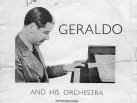 |
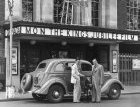 |
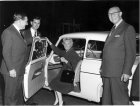 |
Cinema Memories in London
by Gordon Laycock
We lived in New Cavendish Street in London's West End and Robin
Hood was on at the Paramount, Tottenham Court Road. This was a stone's throw up
the road and we joined the queue, eventually getting to the pay desk. One
shilling and nine pence or two shillings and three pence, goodness, father was
paying the higher amount, what a treat! We settled into our seats. The huge
organ rose and we were entertained to a medley of music from the resident
organist. Eventually, after some applause, the organist together with the huge
organ disappeared below the auditorium. Now for the main event in Technicolor,
starring Errol Flynn and Basil Rathbone, I was enthralled. The climax for me
came with the epic sword fight between the hero and the evil 'Sir Guy of
Gisbourne'. It left a lasting impression on me. We came out of the cinema into
the cold street, a short walk and we were soon home.
At ten years old I could indulge my imagination in sword fights with an
imaginary enemy. David, the son of the Jewish tailor, who lived in the flat
below us, would be keen to engage me. We often played in the street against all
manner of traffic, including horse-drawn. Our parents, often so busy to be
unaware of what we were up to or perhaps the danger we were often in. We
survived and certainly became streetwise. It was an interesting time and place
to live.
© Gordon Laycock 2012
More memories
- Frank Richards. Entertainment in Bedford 1920-1939
- Violet Groocock. Recollections of the Empire Cinema, Bedfordshire Libraries, Library Link Magazine, Spring 2000 pp. 16-17
- C. D. Gethins. Klaud's Kinema Column, Bedfordshire Housebound Special, Christmas, 1992 p.13
- C. D. Gethins. Klaud's Kinema Kolumn: The Palace Cinema, Bedfordshire Housebound Special, Spring, 1993 pp.10-11
- C.D. Gethins. Klaud’s Kinema Kolumn: The Picturedrome Cinema, Bedford, Bedfordshire Housebound Special, Summer 1993 p.12
- Beryl Irving. Shadows on the Ceiling, Bedfordshire Magazine vol.7 p.44
- Charles Rose. Hometown Tourist: It was 50 years ago today...., The Bedford Clanger, February 2013 p.2 [ shows at the Granada]
Page last updated: 25th February 2014
